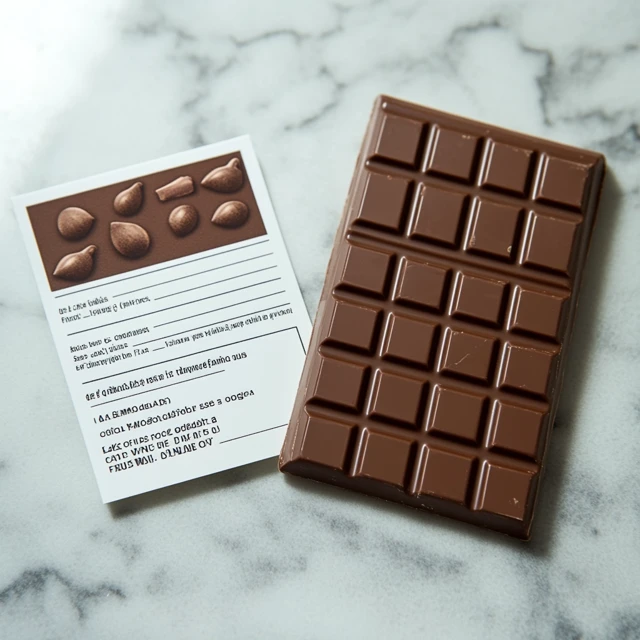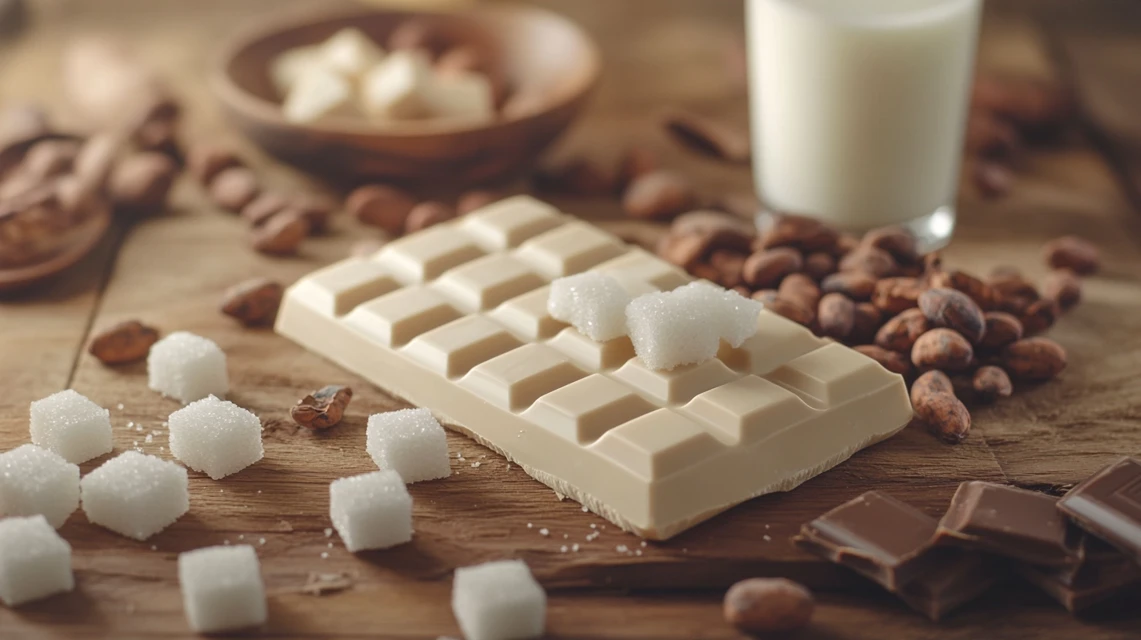Is Milk Chocolate a Junk Food? People worldwide love milk chocolate for its smooth texture and creamy sweetness. As one of the most popular chocolate types, milk chocolate wins fans with its perfect balance of flavors. Yet as health consciousness grows, many wonder about its nutritional value. Understanding milk chocolate’s ingredients and how it stacks up against other chocolate types helps answer this question.
What Is Milk Chocolate?
Milk chocolate is a type of chocolate made by combining cocoa solids, milk, and sugar. Unlike dark chocolate, which contains a higher percentage of cocoa and little to no milk, milk chocolate is lighter and sweeter. Its creamy texture and mild flavor make it appealing to a broad audience, from kids to adults.
Key Characteristics:
- Milder Taste: The addition of milk softens the bitterness of cocoa, resulting in a sweeter and more palatable flavor.
- Creamy Texture: Milk chocolate is smooth and melts easily in your mouth, thanks to its milk content.
- Versatility: It is used in various products, from chocolate bars and candies to baked goods and hot chocolate.
Milk chocolate’s widespread appeal lies in its ability to deliver a satisfying sweetness without the intensity of darker chocolates.
check out this https://eassyrecipes.com/category/breakfast/
Ingredients in Milk Chocolate

The ingredients in milk chocolate play a significant role in determining its nutritional value and whether it could be considered a “junk food.” Most milk chocolates contain the following components:
- Cocoa Solids: These provide the chocolate flavor and contain antioxidants, although in lower amounts than dark chocolate.
- Milk Powder or Condensed Milk: This ingredient gives milk chocolate its creamy texture and contributes to its mild taste.
- Sugar: One of the key contributors to the sweetness of milk chocolate, sugar is also the primary reason for its higher calorie count.
- Cocoa Butter: This natural fat derived from cocoa beans contributes to the smooth, melt-in-your-mouth consistency.
- Emulsifiers: Ingredients like soy lecithin are often added to improve texture and shelf life.
While milk chocolate contains beneficial ingredients like cocoa solids and milk, the addition of sugar and fats makes it less nutritious compared to darker chocolates with higher cocoa content and lower sugar levels.
check out this https://eassyrecipes.com/category/breakfast/
How Milk Chocolate Differs from Other Types of Chocolate
Milk chocolate, dark chocolate, and white chocolate each have distinct characteristics that set them apart. Understanding these differences helps clarify whether milk chocolate leans more toward indulgence or nutrition.
Milk Chocolate vs. Dark Chocolate:
- Cocoa Content: Milk chocolate typically contains 10–40% cocoa solids, while dark chocolate often exceeds 70%.
- Sugar Levels: Milk chocolate has more sugar, making it sweeter and higher in calories.
- Nutritional Benefits: Dark chocolate contains more antioxidants, such as flavonoids, which may provide health benefits like improved heart health.
Milk Chocolate vs. White Chocolate:
- Cocoa Content: White chocolate does not contain cocoa solids, only cocoa butter, sugar, and milk.
- Sweetness and Texture: White chocolate is sweeter and lacks the chocolaty flavor of milk or dark chocolate.
- Nutritional Value: White chocolate offers the least nutritional value of the three, as it lacks antioxidants from cocoa solids.
Where Milk Chocolate Fits:
The smooth texture of milk chocolate balances dark chocolate’s rich bitterness with white chocolate’s sweet creaminess. Though it offers some cocoa-related health benefits, its high sugar and fat content places it firmly in the treat category.
Defining Junk Food
The term “junk food” is often used to describe foods that are high in calories, sugar, or fat but low in nutritional value. While these foods are typically enjoyable to eat, they don’t provide the essential nutrients your body needs to thrive. To determine if milk chocolate qualifies as junk food, it’s important to understand the characteristics of junk food and how milk chocolate fits into a balanced diet.
check out this https://eassyrecipes.com/category/breakfast/
Characteristics of Junk Food

Junk food is characterized by its high levels of calories and low nutrient density. These foods often provide quick energy but lack the vitamins, minerals, and other essential nutrients that promote overall health. Common examples of junk food include sugary snacks, fried foods, and processed treats.
Key Characteristics:
- High Sugar Content: Junk foods are typically loaded with sugar, which can lead to rapid spikes in blood sugar levels.
- Excessive Fats: Many junk foods are high in unhealthy fats, such as trans fats or saturated fats, contributing to weight gain and other health issues.
- Low Nutritional Value: These foods provide empty calories, meaning they lack significant amounts of beneficial nutrients like fiber, protein, vitamins, or minerals.
- Addictive Qualities: Junk foods are often designed to be highly palatable, making them easy to overconsume.
Milk chocolate does contain some of these characteristics, particularly its sugar content, which raises questions about its classification. However, its inclusion of cocoa and milk gives it a slight nutritional edge over other sugary treats.
Is Milk Chocolate Nutritious or Indulgent?
Milk chocolate occupies a middle ground between indulgence and nutrition. While it offers some beneficial nutrients, its high sugar and fat content can shift it closer to the “treat” category.
Nutritional Benefits of Milk Chocolate:
- Cocoa Solids: These provide antioxidants, such as flavonoids, which can improve heart health and reduce inflammation. However, the amount of cocoa in milk chocolate is usually lower than in dark chocolate.
- Milk Content: The milk in milk chocolate contributes calcium, protein, and vitamin D, which are essential for bone health and overall development.
- Quick Energy Source: The sugar content provides a rapid energy boost, which can be useful in moderation.
Indulgent Qualities of Milk Chocolate:
- High Sugar Levels: The sugar added to milk chocolate makes it taste sweet but also increases its calorie content. Overconsumption can lead to health issues like weight gain and tooth decay.
- Fats for Texture: Cocoa butter and added fats make milk chocolate creamy and indulgent but can also add unnecessary calories.
- Low Fiber: Unlike dark chocolate, which contains more cocoa solids and therefore more fiber, milk chocolate lacks the dietary fiber that supports digestion and overall health.
While milk chocolate provides some nutrients, it’s best enjoyed as a treat rather than a primary source of nutrition.
Balancing Treats in a Healthy Diet
Milk chocolate can be part of a healthy diet when consumed in moderation. The key is to balance indulgent foods like milk chocolate with nutrient-rich meals and snacks to maintain overall health and well-being.
Tips for Including Milk Chocolate in Your Diet:
- Practice Portion Control: Limit milk chocolate to small portions, such as a few squares or a mini bar, to enjoy its flavor without consuming excess calories.
- Pair with Nutrient-Rich Foods: Combine milk chocolate with healthier options, like fresh fruit or nuts, to create a balanced snack.
- Choose Quality Over Quantity: Opt for higher-quality milk chocolate with fewer artificial additives and higher cocoa content for a more satisfying experience.
- Time It Right: Eat milk chocolate sometimes as a treat, not every day. This helps you save room for healthy foods in your diet.
The Role of Moderation:
Milk chocolate serves as an indulgent treat rather than a dietary staple. You can enjoy its sweetness as part of a balanced diet by eating it in moderation, which helps maintain your health.
FAQs About Milk Chocolate and Health
Is Chocolate Milk Considered Junk Food?
Chocolate milk is not typically classified as junk food, but its nutritional value depends on the brand and serving size. While it provides essential nutrients like calcium, protein, and vitamin D, it also contains added sugar, which increases its calorie content. This balance of nutrition and indulgence makes chocolate milk more of a treat than a health drink.
Key Considerations:
- Nutritional Benefits: Chocolate milk offers many of the same nutrients as plain milk, supporting bone health and muscle recovery.
- Added Sugars: Drinking too much chocolate milk can add too much sugar to your diet.
- Moderation is Key: Enjoying chocolate milk occasionally and pairing it with a balanced diet can prevent it from being categorized as “junk food.”
Is Dairy Milk Chocolate Junk Food?
Dairy milk chocolate belongs in the treat category rather than serving as a nutritional staple. The milk ingredients add some calcium and protein, but the high sugar and fat content make it more of an indulgent snack.
Why It’s a Treat:
- High Sugar Content: The added sugar in dairy milk chocolate makes it a high-calorie snack, especially when consumed in large portions.
- Low Fiber: Compared to dark chocolate, dairy milk chocolate contains less cocoa, which means it has fewer antioxidants and little to no fiber.
- Balanced Approach: Including small amounts of dairy milk chocolate in a balanced diet can be enjoyable without compromising overall health.
Dairy milk chocolate requires moderation since eating too much leads to high calorie and sugar intake, even though it doesn’t strictly qualify as junk food.
Can I Drink Chocolate Milk Every Day?
Drinking chocolate milk daily is possible, but it depends on your overall diet and lifestyle. While chocolate milk provides important nutrients like calcium, protein, and vitamin D, the added sugar content makes it less ideal for frequent consumption.
Factors to Consider:
- Nutritional Needs: If you’re active or need extra calories for energy, a glass of chocolate milk can be a convenient source of both nutrition and energy.
- Sugar Intake: Monitor how much sugar you consume from other sources to avoid exceeding daily recommendations.
- Health Goals: For weight management or reduced sugar intake, limit chocolate milk to an occasional treat rather than a daily habit.
If you enjoy chocolate milk, consider choosing low-sugar or reduced-fat versions to make it a healthier addition to your routine.
Is Ice Cream a Junk Food?
Ice cream qualifies as a junk food since it contains high amounts of sugar, fat, and calories while providing little nutritional value. Though the dairy ingredients contribute small amounts of protein and calcium, the high sugar and fat content overshadow these minor benefits.
Why It’s Classified as Junk Food:
- High Sugar Levels: Ice cream is packed with sugar, making it a high-calorie dessert that can contribute to weight gain if eaten excessively.
- Unhealthy Fats: Many ice creams contain saturated fats, which can negatively impact heart health when consumed in large amounts.
- Low Nutrient Density: Unlike nutrient-dense foods, ice cream provides empty calories with little to no vitamins, fiber, or essential nutrients.
Balancing Ice Cream in Your Diet:
- Enjoy ice cream occasionally as a treat rather than a regular snack.
- Opt for smaller portions or healthier alternatives, such as frozen yogurt or fruit-based sorbets.
By practicing moderation, you can still indulge in ice cream without it significantly impacting your health.
Conclusion
Milk chocolate, chocolate milk, and sweet treats like ice cream can add joy and fun to your diet, but whether they count as junk food depends on how much you eat. Milk chocolate and chocolate milk offer some nutrients like calcium and protein, but they also have a lot of sugar, so it’s best to enjoy them in moderation. Ice cream, however, is more clearly junk food because it has few nutrients and lots of calories.
By learning about the nutrition in these popular foods and eating them carefully, you can enjoy them as part of a balanced life without hurting your health. Treats like milk chocolate and chocolate milk don’t have to be off-limits—just enjoy them in a way that matches your diet goals.

